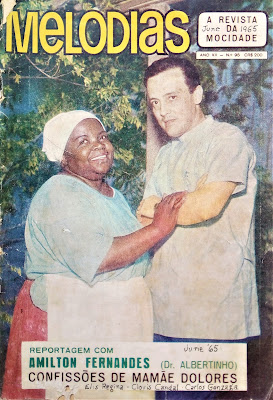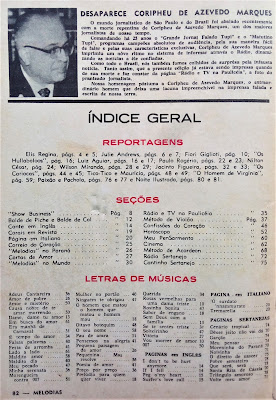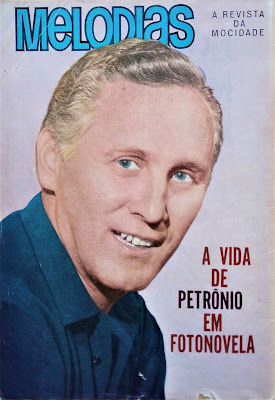Ted Moreno was born Aylton Silva on 30 July 1932, in Rio de Janeiro-DF. He attended Colegio Militar as a teen-ager where he learned how to read music and play musical instruments in order to be in military bands. As he sang well, he tried his luck at some radio station in Rio and soon left the military life forever.
Circa 1952, when Aylton was 20 years old he moved to Sao Paulo where he passed a test to work as a clerk in the State's health system. His day-time job supported his basic needs so he could pursue his real goal: to sing or play the piano, trumpet or guitar at the many night-clubs that abounded in the city. Oasis was the top night club in town and that's where record producer and A&R man Roberto Corte-Real spotted Aylton's and made him change his name to Ted Moreno...
Ted Moreno also performed regularly at Sao Paulo's Radio Record, Tupi and Excelsior. One night radio-man Cesar de Alencar went to Oasis and was impressed by Moreno's talent. Mr Alencar invited him to go back to Rio and sing at his top-rating Radio Nacional show.
From his exposure at the top radio station in the Nation, where he also sang at Paulo Gracindo's Hour, Ted was signed by independent label Todamérica and recorded 'Volte', a 12-track album which introduced him to Brazilian main stream show business.
Ted Moreno's private life was tumultuos. He married quite young but that did not last long. Moreno then went to live in Europe where he married a local lady, but she died not long after.
In early 1959, Ted Moreno shared a night-club act with great Dolores Duran at the Little Club. Media reports suggest they had a love affair. Miss Duran had just arrived back from an European tour of the USSR and France in 1958, had divorced her husband and was in no mood to get married again. Actually, Dolores Duran was living on borrowed time. She would die of a heart attack on 24 October 1959.
Ted Moreno recorded Duran's 'Noite de paz' on his 2nd album 'Falemos de amor' released by Todamérica in late 1959, as a token of his admiration and affection to the unfortunate lady.
Since his early days Ted used to sing at night-clubs in Uruguay's Punta del Este, South America's top gambling resort where he met all kinds of people. A young Argentine psychoanalist fell in love with him. They didn't get married only because she would not leave Argentina and he depended on Brazil to get ahead in show biz.
Ted Moreno in July 1960, when he was 28 years old.
Ted Moreno's first entry at Revista do Radio n. 466 - 16 August 1958.
Moreno's 2nd entry at Revista do Radio n. 468 it's about his 1st album for Todamérica - 30 August 1958.
At A Baiuca in Sao Paulo in 1955: a 23-year-old Ted Moreno (with a moustache) next to Johnny Alf at the piano, Chu Viana at the double-bass and Araken Peixoto at the trumpet.
Revista do Radio n. 490 - 7 February 1959 - Ted is chosen as 1958's best new talent.
Revista do Radio n. 490 - 7 February 1959 ; Ted tells his story to RR.
Revista do Radio n. 498 - 4 April 1959; Ted Moreno's name was linked with that of Dolores Duran, his co-worker at the Litlle Club, who happened to have left her husband Macedo Neto while they were working together. Miss Duran declares Ted Moreno is only a good friend of hers who sometimes takes her out to dinner when they leave their hard working journey. Dolores would die in her sleep before 1959 was over.
Revista do Radio n. 512 - 11 July 1959; apparently Ted Moreno was an impetuous male who could not avoid falling for some pair of good shaped female legs...
Radiolandia n. 271 - 1959.
Radiolandia n. 284 - 1959.
Radiolandia n. 284 - Moreno receives a Disco de Ouro from 'O Globo' for 1958 best new talent.
Revista do Radio n. 566 - 23rd July 1960 - Ted Moreno could not be said to be handsome in the usual way but he had a virile charm that took hold of females' hearts of all sorts. This time he tells Revista do Radio he had a torrid romance with a female Argentine psychoanalist while he was working at a night club in Punta del Este, in Uruguay.
31st December 1959 - 'Correio da Manhã's Nicodemus & Cia tells it like it is: Ted Moreno had been singing nightly at night club Cangaceiro accompanied by Casimiro Granjeiro on the piano.
30 January 1960 - After his stint with Dolores Duran at the Little Club in mid-1959, Ted Moreno shared the stage of Cangaceiro's with Marisa (Gata Mansa) accompanied by Ribamar on piano. Ted was accompanied by Casimiro Granjeiro. This show lasted from November 1959 through early 1961.
27 August 1960 - TV Rio's 'Noite de Gala' on Monday, 22nd August 1960, had Ted Moreno singing 'O céu virá' (Sergio Malta) and 'Ressurreição dos velhos carnavais' (Lamartine Babo).
18 September 1960 - While Julie London sang at the Copacabana Palace, Ted Moreno sang at crowded Bacará.
30 September 1960 - Something went wrong at 'Noite de gala' the night before. After Ted Moreno's performance, they introduced a slide saying international pop-star Paul Anka would be the next. Anka sang a couple of songs and left the stage hurriedly. Oziel Peçanha found out that Paul Anka who was supposed to close the night at 10:30 PM demanded to sing earlier due to his flight arrangements. Dalva de Andrade, who had already been announced by MC Hilton Gomes felt slighted by TV Rio and refused to sing after the Canadian star.
15 October 1960 - Ted Moreno honours Dolores Duran on the 1st anniversary of the beloved singer's passing away.
Ted Moreno's good looks and manly deportment could melt a psychiatrist's heart...
Moreno could read & write music which he learned while training to become a military man.
Revista do Radio n. 589 - 31st December 1960.
Miss São Paulo 1957 falls in love with Ted Moreno; Lucia de Carvalho struts her stuff at the Quitandinha Hotel in 1957.
Revista do Radio tells Ted Moreno & Lucia de Carvalho, Miss São Paulo 1957 were deep in love and would marry in January 1961. They met each other after Lucia won the Miss São Paulo 1957 contest and was in Rio de Janeiro in order to be a contestant at Miss Brazil 1957, at Hotel Quitandinha in Petrópolis-RJ. Lucia went out one night to Scotch Bar where Ted was singing and they started to date. Around this time, Carlos Hugo Christensen was shooting 'Meus amores no Rio' in which Ted Moreno sang a few songs and Lucia appeared as an actress, so their affair was hot as fire and they thought about tying the knot. But, Ted had to travel to Argentina and the romance cooled off. Now, 3 years later, in late 1960, they met again and decided to marry and live in Rio de Janeiro.

Radiolândia n. 346 tells a different story about Ted & Lucia Carvalho's engagement. According to Radiolandia, Lucia, who started a career as a singer was eager to get the media's ear and 'invented' an engagement with Ted Moreno that was a fib.
Revista do Radio n. 615 - 1st July 1961: Ted Moreno marries Adelia Figueiredo Eyer
Is it possible Ted Moreno was a two-timing man? In January 1961, he was supposed to have married Lucia de Carvalho, Miss S. Paulo 1957. Then, less than 4 months later Revista do Radio says Ted Moreno married Adelia Figueiredo Eyer?
The article doesn't even mention Miss Sao Paulo 1957. It just says Moreno & Ayer decided to get married secretly in Caxias-RJ on 31st May 1961, then fly to São Paulo and get married at a Catholic Church in that city on the following day 1st June 1961.
Revista do Radio n. 687 - 17 November 1962.
Radiolandia n. 391 - early 1963, announces the birth of Patricia Fernanda, Ted & Adélia's daughter who would be baptized by song-writer Fernando Cesar and his wife Arlete.
Revista do Radio n. 713 - 18 May 1963 - 'Musical Ted Moreno' at 8:30 PM on Wednesdays at Rio de Janeiro's TV Continental Channel 9.
Radiolândia n. 247.
'Cinelândia' n. 317; an overall view of the records page in mid-1966. Ted Moreno worked at Rio de Janeiro's TV Continental, Channel 6 as an arranger-orchestra conductor for Moacyr Franco in his weekly variety programme. See that The Beatles' 'Revolver' was the no.1 album in Argentina, followed by 'Sombra, una guitarra y boleros' with José Feliciano at #2, 'La novicia rebelde' ('The sound of music' s sound-track) at #3; 'Strangers in the night' with Frank Sinatra at #4 and 'Coronación de la Cumbia' with Los Wawanco at #5.




.jpg)








































































